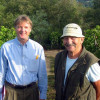
THE RETURN OF ANIMALS TO THE VINEYARD
WINTER-SPRING 2024
ORGANIC GRASSES & THEIR OVINE MUNCHERS
The commendable efforts by growers to re-connect with the land and ancient practices started a few years ago with the return of horses to plough the vineyards. For many years, there has been a heroically named horse at the biodynamic and organic Le Mas de Libian in the Southern Ardèche, where Bambi has taken the mantle of Nestor, who died aged just 18 in 2018.
Hélène Thibon at Libian has always been forward acting in matters of the environment, with her 25 hectares of mainly Côtes du Rhône vineyards on clay-limestone gentle inclines allowing ease of work for Bambi. As an organic and biodynamic domaine, she has a committed following among les branchés, the informed drinkers and enthusiasts, and is much respected by other growers across France.
There has also been a tradition of some degree of horse cultivation at Hermitage in the Northern Rhône – an older, more historic vineyard with more means about it. This lapsed when I was a young man, but started to re-appear in that most technical of decades, the 1980s, which was a surprise: these were the years of spraying by helicopter and no holding back on chemical use for many.
The brothers Cotte were mixed farmers nearby in the Drôme [cows, goats, corn, apricots, asparagus] and kept two working horses that would sleep in a little stable in the vines, owned by Jean-Louis Grippat until he retired and sold it to Marcel Guigal.
One hectare would take 18 hours’ work, the brothers strapped behind them and staggering along at speed behind the mighty beasts, accompanied by grunting noises and throaty commands such as “yap” and “doucement”. Two trips per row were made, to turn the soil on each side of the vines. The season for the horses ran from March to September.
Growers using them on lower lying sites such as Les Murets, Beaume, and parts of Le Méal and Les Greffieux were Marc Sorrel, Jean-Louis Chave, Guigal and Bernard Faurie, with Chapoutier having their own two horses.
More recently, there has been the arrival of sheep to help to fertilise the vineyard, their season the opposite, being over the winter until around April, when the shoots start to appear. They do not require heavy hours of invigilation, with an outlay on fencing and occasional shifts [note the f] of venue. In the Northern Rhône, Rémy Nodin at Saint-Péray and Julien Barge at Côte-Rôtie have been shepherds for the past three years or so.
The Nodin domaine has been officially organic since the 2022 vintage, the sheep in situ since 2020. Rémy and Amandine use a flock of 40 female adults or brébis. “The benefits are to rid the vineyard of stubborn weeds such as ivy and couch grass [chiendent] and provide a natural manure, as well as giving a belle image for the domaine,” states Amandine.
She also notes that they have not been frosted on areas where the sheep have pastured, and reduced the height of the grasses from 15-20 cm in the spring. The Nodins estimate a gain in time in looking after the soils following the sowing of seeds between the rows. There will also be wool products coming along.
Another Northern Rhône grower, Jef Malsert of Domaine de l’Iserand high up at Saint-Joseph, has also used sheep: “I plant rye, beans, clover, for example, between the rows, then turn the soils late on. I have used sheep on half a hectare, with very good results, they are there from leaf fall until April or so, not later. I tried mules, but they use the same s**t hole all the time, meaning I have to distribute it, which is not part of the deal!”
Away from the slopes and ledges of the Northern Rhône, there is some serious sheep activity at the organic Domaine Les Ondines at Vacqueyras, whose Jérémy Onde also owns vineyards at Sablet, Plan de Dieu, Séguret, Travaillan and Beaumes-de-Venise – plenty of munching there.
Jeremy tells his story: “I started the sheep three years ago, and now have 147. I sell the males, and the sheep are in the vineyard only during the winter. I don’t need them to cut right back the grasses and weeds, what they leave is a more fine grass that also facilitates the tractor to go through the rows, plus their droppings of course. They are a work tool behind the tractor, and I can use them to take out grass on precise spots.
I bought a Bordier Collie recently to direct them, notably along the edges of vineyards. I admit that the project didn’t start well – it was like an American arriving in Vacqueyras, with the locals licking their lips: I was sold sheep at a high price, there were sheep with problems, and I was seen off. The cost for me amounts to the fencing and my time with them.”
I expect sheep to become a common sight during the winter months in future, their presence and sound of tinkling bells a re-assuring backdrop to the re-vitalization of the vineyards, and helping the land to cope better with summer extremes.

